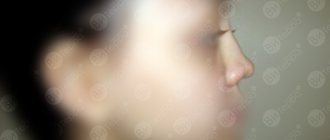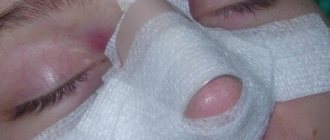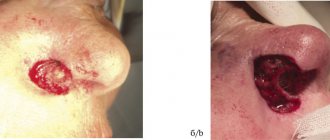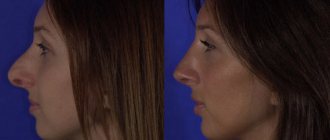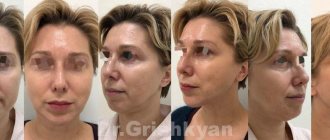Closed rhinoplasty is a technique for performing nose surgery using endonasal access (through incisions inside the nose). The main difference from open rhinoplasty is that the surgeon makes all the incisions inside the nasal cavity, on its mucous membrane.
Closed rhinoplasty is aimed at changing the shape of the nose, its size and length using the endonasal method. The stitches after closed rhinoplasty are hidden from surrounding eyes. The closed method of rhinoplasty, along with open access, is actively used by many modern rhinosurgeons.
Indications for surgery
- Nasal asymmetry;
- Narrow (or too wide) nasal passages;
- Deformed nasal passages;
- Hump;
- Deviation of the nasal septum;
- Wide nose;
- A long nose;
- Thickened tip (potato nose).
Closed rhinoplasty is more gentle. During it, the columella is not affected and, accordingly, the arteries are not damaged, so rehabilitation is faster and easier than after open rhinoplasty.
Benefits of closed rhinoplasty:
- No visible scars. All incisions are made from the side of the nasal mucosa.
- Shorter and easier rehabilitation period in contrast to open rhinoplasty. During surgery, the columellar arteries remain intact, resulting in less pronounced swelling.
With both closed and open rhinoplasty, excellent correction results can be achieved. The main condition for a successful operation is the rhinosurgeon’s perfect mastery of the chosen nose surgery technique.
general information
The key difference between the methods under consideration is the localization of the surgical approach.
Closed rhinoplasty is performed through an internal approach. The incisions pass through the mucous membrane of the nasal passages; the skin of the wings and columella is not damaged. With this option, the plastic surgeon actually receives two independent accesses to the deep anatomical formations of the left and right halves of the nasal skeleton, which somewhat worsens the visibility of the surgical field. Open rhinoplasty is performed through an external approach. The incisions are made along the skin of the thin septum between the nasal passages (called the columella) and the wings. A longer and, most importantly, continuous incision allows the plastic surgeon to move the skin of the tip towards the bridge of the nose and get an excellent view of the internal anatomical structures (cartilage, bones) that need to be changed. After correction, small scars remain at the incision site, which over time become almost invisible.
How is the operation performed?
The initial stage of the operation is a consultation with a plastic surgeon, who must take into account all the wishes of the patient and, having studied the anatomical features of his nose, model the future shape of the nose.
After determining the indications and the extent of the necessary correction, the doctor draws up a detailed surgical plan. Before closed rhinoplasty, the patient must undergo the necessary clinical and laboratory tests. Additional examinations may be carried out as prescribed by the doctor.
“The fact is that in the case of the open method, the rehabilitation period is sharply prolonged. The swelling lasts longer, the nose takes its final shape later... The closed one has a much shorter recovery period, and with this method, if indicated, an experienced surgeon will do an excellent job. The closed method is applicable if this is a primary treatment, and the patient’s complaints are no longer about the tip of the nose, but about the osteochondral pyramid (hump, curvature of the nose). Septoplasty (correction of the septum) for breathing problems can be performed using any of the methods. In aesthetic terms, there is no difference between the two methods, that is, by the appearance of the nose it will not be possible to tell by what method rhinoplasty was performed. But, as I said, there are variants of noses and deformities when an open technique will definitely be chosen.”
Tamarov Alexey Nikolaevich plastic surgeon
Features of correction of a deviated nasal septum
The timing of nasal septum correction directly depends on the specific patient and clinical case. Depending on the complexity and purpose of the operation, there are two main methods of performing the operation:
- Open way
- Closed method
Open rhinoseptoplasty
When performing rhinoseptoplasty using the open method, you can not only straighten the septum, but also correct the shape of the nose. Thanks to the incision between the nostrils and the separation of soft tissues, it is possible to carry out a complete reconstruction of the nose. In this case, the patient will be able to remove the hump on the nose, narrow or widen the wings of the nose, and enlarge the bridge of the nose, if their own tissues allow it or with the help of grafts.
Closed rhinoseptoplasty
With the closed method of correcting a deviated nasal septum, the incisions are made inside the nose, which means that the scars, in principle, will not be noticeable after rehabilitation. In this way, it is also possible to solve two problems at once related to the normalization of breathing and the aesthetic shape of the nose. But even this method, attractive at first glance, has its drawbacks. When performing an operation, the surgeon does not have an open picture of all cartilaginous tissues, so in complex clinical cases this method will be ineffective. The choice of technique lies entirely on the shoulders of the plastic surgeon, because only an experienced doctor will be able to assess the situation and the required volume of the operation.
Stages of closed rhinoplasty
- The surgeon makes transcartilaginous and transfection incisions. Then the soft tissue is separated from the bone and cartilage.
- After the surgeon has carried out all the manipulations with the osteochondral tissue, the skin at the incision sites is sutured.
- The nasal mucosa is sutured with absorbable suture material.
- The operation takes about 1.5 hours and is usually performed under general anesthesia.
Cost of closed rhinoplasty
| Name | Price |
| Full rhinoplasty | 230,000 rub. |
| Stay in the observation room (up to 3 hours) | 3,000 rub. |
| Primary appointment (examination, consultation) with a plastic surgeon | FOR FREE |
Endoscopic rhinoplasty (author's technology Savinkov ERSAV.)
When performing endoscopic rhinoplasty or rhinoseptoplasty, the surgeon sees the entire progress of the operation on the monitor. The image is transmitted using video cameras connected to an endoscope, which the rhinoplasty surgeon inserts into a 3 mm incision. All surgical instruments in endoscopic rhinosurgery have a diameter of no more than 3.5 mm.
The operations are bloodless, low-traumatic and allow us to solve the tasks of correcting the shape of the nose set by the patient with pinpoint accuracy.
The effectiveness of endoscopic rhinoplasty ERSAV. significantly higher than with open or closed rhinoplasty. In addition, endoscopic surgery can fundamentally improve the results of surgery to restore nasal breathing.
Endoscopic ENT operations (endoscopic, endoscopic, other endoscopic operations on the nasal cavity and sinuses) using modern techniques, equipment and instruments are low-traumatic, painless and practically bloodless, so the patient, as a rule, stays in the clinic for one day.
Closed nose tip rhinoplasty
Often nasal tip plastic surgery is performed using a closed approach. Through endonasal incisions of the nose, the cartilage of the nostrils is released and the shape of the tip of the nose is corrected with sutures. This method has a drawback: the doctor does not have the opportunity to use various techniques to achieve the best result. A competent rhinosurgeon must be able to master both techniques of rhinoplasty.
Example of closed rhinoplasty
Indications and contraindications
Medical indications
This group of reasons directly indicates an objective deterioration in health, general well-being and a decrease in the patient’s quality of life:
- Congenital disfiguring anomalies;
- Acquired disfiguring defects;
- Any anatomical defects with impaired respiratory function (external respiration function);
- Anatomical anomalies of various types with clinical manifestations - frequent bacterial, viral infections, inflammatory reactions. Or other types of changes;
- Performing the final stage in complex reconstructive operations on the face;
- A significant cosmetic defect in itself is the cause of severe complexes with the formation of affective changes of the depressive type;
- Carrying out repeated correction.
In this situation, how much rhinoplasty costs depends solely on the type and volume of manipulations performed.
Aesthetic indications
Somewhat different from them is a group of aesthetic reasons, in which initially there is a person’s desire to change his own appearance by having rhinoplasty, for subjective or objective reasons, but there are no clinically significant changes in breathing, smell, etc.:
- Disproportionality of size;
- Visually saddle-shaped configuration;
- Any curvature of the nasal bridge;
- Hump-nosed;
- Increased area of the nostrils;
- Anatomical abnormalities of the tip of the nose;
- Any asymmetry, especially of the wings of the nose and nostrils;
- A combination of several different defects;
- The client’s subjective desire to have a nose of a certain “star nose” configuration;
- Purely subjective dissatisfaction of the patient with his own appearance.
The price of rhinoplasty in Moscow for aesthetic reasons is determined based on market demand and is more flexible than in clinically determined cases.
Relative contraindications
The most significant group of relative contraindications is in which the specialist postpones in time the moment when rhinoplasty of the tip of the nose or another type of plastic surgery of the nose will be performed. Normalization of the condition (in case of illness), or over time (age, course of treatment, other points), correction can be carried out without restrictions:
- Age less than 18 years due to the continued formation and maturation of the bone tissue of the facial skull;
- Pregnancy and lactation;
- Inflammatory, viral, bacterial processes of the mucous membrane and skin at the site of surgery;
- Acute course of somatic pathology, or exacerbation of chronic disorders;
- A medically prescribed course of pharmacological agents with an effect on hemostasis.
Absolute contraindications
- Verification of oncological diagnosis;
- Most severe mental disorders;
- Severe, uncorrectable hemostasis disorders;
- Progressive severe metabolic and somatic pathology;
- Initially impossible requirements of the patient due to anatomical and structural features;
- Insistent demand for objectively clearly disfiguring results.
A separate point is necessary to highlight the situation when the patient already had unsuccessful repeated experience of operations in the anamnesis. Many have seen such a nose after rhinoplasty, before and after photos are very common in all media, and especially on the Internet, and the sad experience of many stars is in plain sight. On the one hand, this is a professional challenge for a specialist, an opportunity to help a person in truly advanced cases, when the chances of a positive outcome are minimal. On the other hand, it has been proven that there is a change in not only anatomical structures, but also histoarchitecture at the micro level, and each subsequent intervention aggravates these changes.
Dr. Aleksanyan is one of a negligible number of specialists who offer their patients the opportunity to undergo rhinoplasty in Moscow in such clinical situations. An exceptionally scrupulous, competent and balanced assessment of even the smallest details and objective features of the condition of the client’s entire body and the site of future surgery, filigree, jewelry technique for performing surgical procedures and the use of the most effective techniques in working with exceptionally high-quality equipment allow Tigran Albertovich to achieve success in extremely complex situations. cases.
Contraindications
- Infectious and viral diseases in the acute stage;
- Serious diseases of internal organs;
- Diabetes mellitus, oncology;
- Blood clotting disorder;
- Pregnancy, lactation.
Closed rhinoplasty (like open rhinoplasty) is not recommended for patients under 18 years of age, due to insufficient development of osteochondral tissues. However, in the presence of injuries and other pathologies, nose surgery can be performed at an earlier age with the consent of the parents.
Definition of Rhinoplasty
Rhinoplasty is a separate branch of aesthetic facial surgery, aimed at correcting a wide range of defects of various etiologies through correction or restoration of anatomical structures. According to the generally accepted definition of experts from the WHO profile committee, rhinoplasty is an independent branch of plastic surgery that deals with the development, implementation and practical application of methods for invasive correction of acquired or congenital anatomical anomalies, as well as the restoration of external or internal missing structures.
Rehabilitation after closed rhinoplasty
The rules for rehabilitation after closed rhinoplasty are no different from the recommendations for recovery after open rhinoplasty. Immediately after the operation, the surgeon places a fixation splint on the patient’s nose. After a week, the plaster is removed, and you can already evaluate the primary result of rhinoplasty. The final effect of the correction will be achieved in approximately 6 months, when the healing process of the nasal tissues is completely completed.
Surgeon's recommendations for the rehabilitation period:
- It is forbidden to remove the turundas and remove the plaster cast on your own;
- For 2 weeks, it is advisable to sleep only on your back;
- Do not get the plaster cast wet;
- It is advisable to limit physical activity and try not to tilt your head forward;
- During the first days, it is advisable not to eat too cold or hot food (drinks).
The result of closed rhinoplasty can be assessed 2-3 months after surgery. The choice of rhinoplasty approach depends on the surgeon. It is based on the indications for surgery, the wishes of the patient and the experience of the plastic surgeon in performing this technique of nose surgery. Rhinosurgeons at our clinic are equally masterful in both techniques of performing nose surgery.
Open and closed rhinoplasty - what to choose?
Closed or open rhinoplasty? A lot of review materials on the Internet are devoted to this topic, plastic surgeons often post on social networks about these methods of nose correction, and patients debate and try to determine which is better. Unfortunately, we cannot give you a definite answer to this question. This is because it simply does not exist. Both open and closed techniques provide excellent results when performed by an experienced plastic surgeon. When we were writing this material, we turned to Alexandra Leonidovna Moshkalova, a leading specialist at the Galaxy Beauty Institute in St. Petersburg, for comments.
Open and closed methods: pros and cons
Plastic surgery on the nose, be it open or closed rhinoplasty, will help cope with aesthetic and functional deficiencies of the respiratory organ:
- birth defects
- hypertrophy and polyps of the nasal concha
- absence or difficulty in nasal breathing
- deviated septum
- crook in the nose
- asymmetric wings
- nose too long
- nasal deformation due to trauma
- nostrils that are too large or too small, etc.
The operation takes from 30 to 120 minutes, depending on the complexity of the operation and the experience of the doctor.
During open rhinoplasty, the surgeon makes an external incision in the columella. With the closed method, all incisions are made inside the nose. And it is precisely this fact that makes it a priority for patients. But patients are not plastic surgeons, so they cannot know all the intricacies of the operation. And judging which method is better based on just one criterion is not entirely correct.
The result of closed rhinoplasty 3 weeks after surgery. Narrowing of the nasal bridge, correction of asymmetry of the tip and bridge of the nose, narrowing of the tip of the nose, shortening of the nose, reduction of the nostrils, bullhorn were performed
Ardent fans of the closed technique, in addition to the absence of postoperative scars, cite the disadvantages of open access:
- additional incision in the columella area
- increase in operation time
- longer lasting swelling and loss of sensation
Among the advantages of closed surgery, its supporters accordingly name: reduction in the duration of the operation, rehabilitation time, reduced postoperative swelling, and absence of risk for the formation of an external columellar scar. Closed access allows you to preserve the important circulatory arteries of the nasal columella.
Alexandra Moshkalova comments
The fact of preserving the integrity of the arteries and the columella itself is technically clear and appreciated by doctors. As for patients, for them these features have a more obvious advantage - after surgery there is less swelling, faster recovery and there are no scars.
We continue to compare: eliminating pathologies
And although it may seem that there is nothing better than a closed method, do not rush to conclusions. The fact is that most often doctors choose closed access for normal anatomy, when the purpose of the operation is not to eliminate the defect, but to improve the nose with slight deviations from aesthetic standards.
Elimination of significant defects using the endonasal method is possible only by a highly qualified experienced specialist, and in complex cases when a meticulous reconstruction of the organ is required, regardless of the surgeon’s skill level, an open technique would be advisable. The main reasons for this choice are related to the possibility of direct visual control during the operation, which is especially important when it comes to atrophy of the bone or cartilaginous structures of the respiratory organ. Having the best possible view makes the job easier, but the columella incisions can make it slightly more difficult to assess the shape of the nose and the degree of rotation on the operating table.
As for closed rhinoplasty, it also has its own specific features. Thus, this method of correction of the olfactory organ has a small, but still risk of deformation of the nasal cartilage due to strong stretching of the tissues.
Alexandra Moshkalova comments
If a specialist has difficulty visualizing anatomical structures and does not see them well enough, then in some cases he may take additional actions with the soft cartilage of the wings of the nose, which will cause their deformation. This, in turn, can cause asymmetry of the tip of the nose. A number of experts insist that if during closed rhinoplasty it is necessary to correct the vaults and arches of the wing cartilages, then the lack of full visual control makes it almost impossible to create ideal symmetry. However, although these risks exist, the main role here is played by the qualifications of the surgeon who will be able (or not) to achieve the desired result without complications.
I think it is fair to admit that there is a problem when placing implants in closed rhinoplasty. This is either very difficult or impossible, depending on the type of grafts. Open rhinoplasty will be the only correct solution in such a situation, so surgeons will never refuse such a technique, which will provide the patient with both aesthetics and safety of surgical intervention.
Surgical field for closed rhinoplasty
The open technique provides a wide and complete overview of the surgical field, while the closed approach complicates the work of doctors. Adherents of the open method call this their main advantage, but patients begin to doubt what the plastic surgeon sees and whether the internal structures of the nose are seen at all during endonasal rhinoplasty. Frankly speaking, when using the closed method, specialists work almost blindly; with the ability to apply this skill, which, of course, will only be developed with extensive experience and good teachers, the method gives every opportunity to achieve a natural result, prevent drooping of the nasal tip in the future and reduce post-operative period.
Alexandra Moshkalova comments
The importance of visual visibility in open rhinoplasty is somewhat exaggerated, since the closed method also allows you to see the cartilage. And provided that the surgeon has chosen the right approach, the doctor will be able to observe the entire back, right down to its transition to the frontal bone. Closed rhinoplasty in no way reduces the ability to control the entire surgical process; we do not even require any specific instruments. Conventional, standard equipment is used, and an endoscope can be used if necessary. The highly qualified surgeon, his skills and knowledge make it possible to successfully and efficiently carry out closed nose correction without a large space.
Rehabilitation after rhinoplasty
The patient spends the day after the operation in the clinic under the supervision of medical staff. Internal turundas, which are installed in the nasal passages at the end of the operation to fix the new shape of the nose, are removed on the second day after rhinoplasty.
At first, the patient’s face will experience swelling and bruising, and there may be an increase in body temperature. These are common postoperative phenomena - this is how the body’s reaction to external intervention is expressed. There may also be mucous discharge from the nose with small amounts of blood - this is within normal limits. If the bleeding is heavy, contact your doctor immediately, as a complication is obvious. Sensitivity in the operated area and upper lip may be temporarily impaired, but after a while this side effect will disappear on its own. A cast must be worn for the first couple of weeks.
To reduce the appearance of edema and speed up recovery, you need to sleep on a high pillow and stop smoking and drinking alcohol. To prevent possible complications, active physical activity, visits to baths, saunas and solariums, and sunbathing are prohibited in the first months.
Alexandra Moshkalova comments
Rehabilitation after rhinoplasty means 7 days of wearing a plaster cast; 1-2 weeks of bruising and swelling. This is not to say that the difference in recovery after open or closed rhinoplasty is too different, although in the latter case the recovery is still slightly shorter. The individual characteristics of the patient’s body are much more important here. If he has a tendency to swelling, then it may be that his recovery after a closed nose correction will take longer than for another patient after an open one.
After removing the plaster, the patient immediately sees how the nose has changed, but the final result can only be assessed after 6-8 months. I would like to note that it is advisable to fly on an airplane without plaster no earlier than 3-4 weeks later. At the same time, you can fly with a cast in the first 2 weeks after rhinoplasty; after removing the cast, I often reapply the cast specifically for the flight.
Patient's personal history
The latest data on the number of rhinoplasties performed concerns 2017, when aesthetic nose correction accounted for 10% of the total number of plastic surgeries performed. Statistics for 2018 have not yet been collected, but it is fair to admit that the number of patients considering rhinoplasty every year is increasing exponentially. People no longer want to put up with flaws that prevent them from admiring their appearance. Elena Manilova told us about her story, who at the age of 23 decided to undergo rhinoplasty and had it done by Dr. A.L. Moshkalova.
Commented by Elena Manilova (St. Petersburg)
I am very glad that I live at this time, when it is realistic to have an operation and get rid of my long-standing complex. We all know that more attractive people have an easier time both at work and in relationships, but since I was a teenager I couldn’t call myself beautiful. Individual facial features could really attract attention, but the overall impression was spoiled by my nose. He was very big and hunchbacked. I myself am petite, and my facial features are generally thin, but my nose... Have you watched the cartoon “Little Mook”? I looked about the same.
Naturally, I didn’t like myself, and I didn’t look particularly good in the mirror either. What kind of cosmetics could we even talk about if you can’t see my face behind my nose? In short, I struggled with my nose before entering university. There I already learned that it is possible to have plastic surgery, and I started communicating with girls who had already undergone surgery. The most interesting thing is that no one told me that rhinoplasty is easy. No, everyone advised me to carefully weigh the pros and cons, although they supported me. Of course, they probably never dreamed of such a nose. So, for a couple of years I studied information about the operation, saved for it, and consulted with my mother, who did not object. For a long time I chose a surgeon, because I want both a professional and a pleasant person. How can you trust him with your face? I even met boors at my neighborhood clinic, but for my money I only wanted to communicate with worthy specialists.
In the end, I chose Alexandra Leonidovna Moshkalova. The rhinoplasty they did on me was incomparable: they removed this hump on my nose, narrowed the back, then slightly adjusted the wings and the tip of the nose. It was a large-scale operation, so to speak, because otherwise the nose could become disproportionate. And so - they fixed everything in a comprehensive manner at once and made the most gorgeous nose.
I have never regretted my surgery or my choice of doctor. If I had known what a great result would be, I would have persuaded my mother to have plastic surgery even earlier, right at the age of 18, because the changes are simply unrealistic. I feel beautiful, I feel confident. Even my friends said that I had changed. This is cool, because after rhinoplasty I lost all the psychological complexes that made me suffer when I had my old nose. I always argue with people who say that plastic surgery is bad. On the contrary, thanks to plastic surgery, a person can get a chance to live their real life, and not hide or feel embarrassed about themselves because of their appearance.
What types of rhinoplasty are there?
- Rhinoplasty - only changes the appearance of the nose (such operations are performed by patients who do not experience functional problems)
- Septoplasty is an operation that straightens the nasal septum and improves breathing. This is a functional operation that does not entail external changes in the respiratory organ.
- Rhinoseptoplasty - this operation is performed to immediately restore breathing and improve the appearance of the nose.
These are the main three subtypes of rhinoplasty.
Open rhinoplasty of the nose
The open type of rhinoplasty is considered a classic option; it has been practiced for many years. The procedure allows the doctor to have visual contact with the site of manipulation. A small incision is made on the columella, and if necessary, it is also made along the wings of the nose. Next, the epithelium is separated from soft, cartilage and bone tissues with special scissors. Using a hook, the skin is pushed upward, and then the operation begins.
This method is familiar to every professional plastic surgeon. It allows you to perform complex operations in the nose area, correct severe asymmetry or completely restore the shape of the respiratory organ after severe injuries or illnesses, and helps get rid of a nasal hump. The same technique is also chosen in cases where revision rhinoplasty is performed.
Indications for open rhinoplasty
Open nose correction is addressed when:
- desire to shorten or reduce a long, wide nose;
- the need to reduce the nostrils;
- pointed, thickened tip of the respiratory organ;
- the presence of deformations of the respiratory organ resulting from injury;
- desire to eliminate the hump;
- congenital pathologies of the respiratory organ;
- low dorsum or saddle nose configuration;
- snub nose.
Also, an open type of rhinoplasty is used by a specialist if the patient has a deviated nasal septum, and this leads to breath retention.
Answers to popular questions from patients
Is there a difference between contraindications for closed and open rhinoplasty?
The list of contraindications for rhinoplasty is determined together with a specialist. In most cases, both open and closed types of plastic surgery have the same contraindications. It is better to consult a doctor about this in person.
Is it possible to perform a closed type of rhinoplasty under local anesthesia?
This depends on the specific situation and the level of change required. If minor correction is necessary, local anesthesia is allowed. Complete rhinoplasty requires only general anesthesia.


